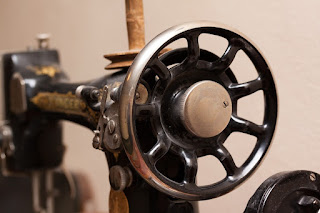 |
Singer Sewing Machine Close-up Photo by stux at
https://pixabay.com/photos/sewing-machine-singer-old-antique-1789198/ |
This world history resource focuses on the Industrial Revolution
from 1700 to 1900 and includes quiz questions and answers
and video links to related topics.
I utilized World History: Patterns of Interaction (Holt McDougal)
for our world history textbook.
It has multiple options for different learning styles
and covers a wide array of information.
This quiz accompanies Chapter 25: pages 714-743.
Directions for the quiz:
- Scroll down and click on the thumbnail to enlarge to full screen.
- Click on the graphic to advance to the next screen.
- Choose an answer for each question.
- Compare your answers with those provided.
If you are interested in a group and/or interactive version of this quiz, visit Kahoot! and search for Week 25 World History by Katrena_Wells.
Below are free videos to accompany chapter 25:
Thanks for visiting my Student Survive 2 Thrive blog.
Navigate my blog easily through my site map, topics
tabs on the right, or via my search bar.
Here are a few of my articles you may also find helpful this week:
 |
| World History Week 25 The Industrial Revolution 1700-1900 |
 |
| Created by Katrena. All rights reserved. |
 |
The ___ Revolution began in England in the mid-1700s
when many jobs were transformed from hand-made to machine-made goods.
Answer choices include: Industrial, European, Agricultural, Internet |
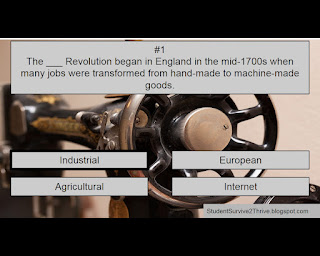 |
| The correct answer is Industrial. |
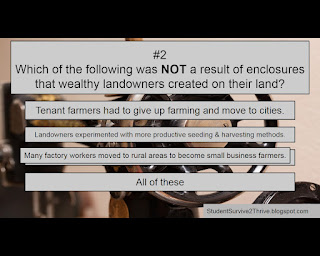 |
Which of the following was NOT a result of enclosures
that wealthy landowners created on their land?
Answer choices include:
Tenant farmers had to give up farming and move to cities.
Landowners experimented with more productive seeding & harvesting methods.
Many factory workers moved to rural areas to become small business farmers.
All of these. |
 |
The correct answer is:
Many factory workers moved to rural areas to become small business farmers. |
 |
Planting different crops in a field in order
to replace nutrients is known as crop ___.
Answer choices include: revolution, recycling, reduction, rotation |
 |
| The correct answer is rotation. |
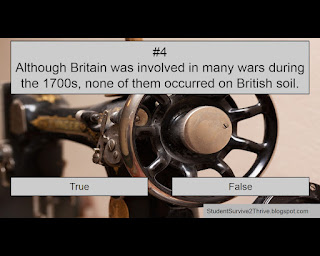 |
Although Britain was involved in many wars during the 1700s,
none of them occurred on British soil.
Answer choices include: true, false |
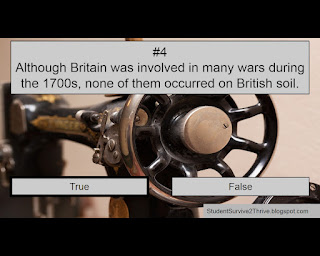 |
| The correct answer is true. |
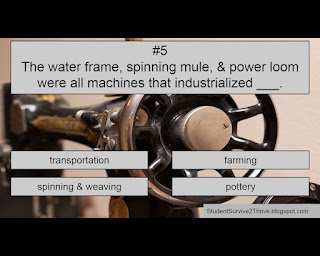 |
The water frame, spinning mule, & power loom
were all machines that industrialized ___.
Answer choices include: transportation, farming, spinning & weaving, pottery |
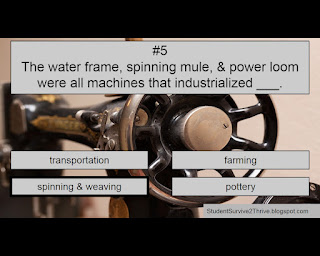 |
| The correct answer is spinning & weaving. |
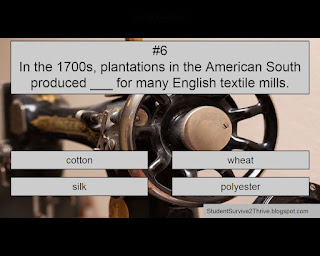 |
In the 1700s, plantations in the American South
produced ___ for many English textile mills.
Answer choices include: cotton, wheat, silk, polyester |
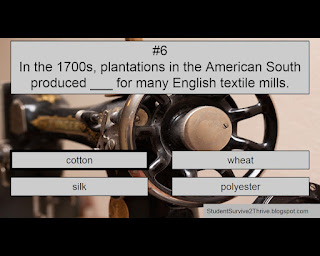 |
| The correct answer is cotton. |
 |
A/n ___ is a person who organizes, manages,
& takes on the risks of a business.
Answer choices include: employee, inventor, scientist, entrepreneur |
 |
| The correct answer is entrepreneur. |
 |
Which of the following is FALSE regarding
railroads in Britain in the early 1800s?
Answer choices include:
They created new jobs for miners.
They put England’s agricultural & fishing industries out of business.
They encouraged city swellers to vacation in countryside resorts.
They boosted manufacturing by providing a cheap way to transport materials. |
 |
| The correct answer is: They put England’s agricultural & fishing industries out of business. |
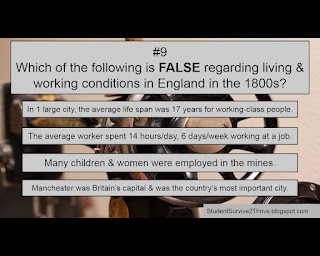 |
Which of the following is FALSE regarding living & working
conditions in England in the 1800s?
Answer choices include:
In 1 large city, the average life span was 17 years for working-class people.
The average worker spent 14 hours/day, 6 days/week working at a job.
Many children & women were employed in the mines.
Manchester was Britain’s capital & was the country’s most important city. |
 |
| The correct answer is: Manchester was Britain’s capital & was the country’s most important city. |
 |
Which organization(s) or laws seek to protect children
from unsafe and inhumane working conditions?
Answer choices include: Child Welfare League of America,
International Labor Rights Fund, Factory Act of 1819, All of these |
 |
| The correct answer is all of these. |
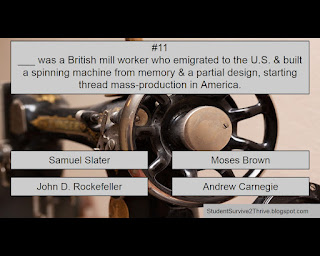 |
___ was a British mill worker who emigrated to the U.S. & built
a spinning machine from memory & a partial design,
starting thread mass-production in America.
Answer choices include: Samuel Slater, Moses Brown,
John D. Rockefeller, Andrew Carnegie |
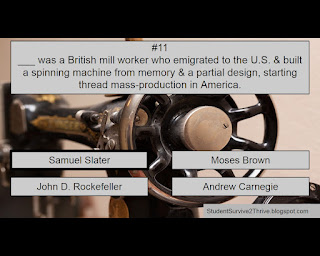 |
| The correct answer is Samuel Slater. |
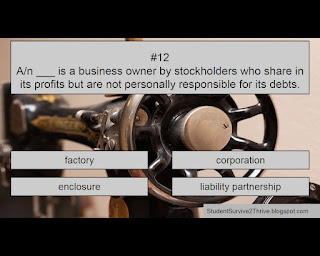 |
A/n ___ is a business owner by stockholders who share in its profits
but are not personally responsible for its debts.
Answer choices include: factory, corporation, enclosure, liability partnership |
 |
| The correct answer is corporation. |
 |
Which European country was the first to begin
adopting Britain’s new technology in 1799?
Answer choices include: Germany, Bohemia, Belgium, Spain |
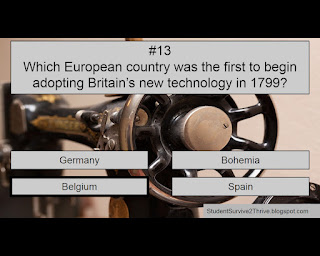 |
| The correct answer is Belgium. |
 |
Which European country industrialized in a more controlled manner,
avoiding social & common economic problems of the early & mid 1800s?
Answer choices include: Italy, Russia, Austria, France |
 |
| The correct answer is France. |
 |
Laissez-faire thinking sought to help poor workers & fought
to create minimum wage & better working conditions.
Answer choices include: true, false |
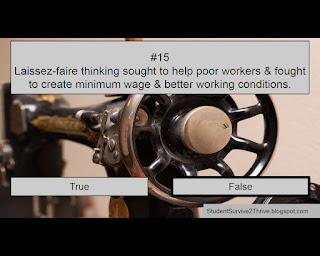 |
| The correct answer is false. |
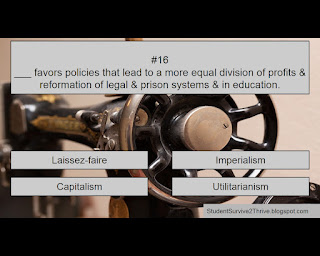 |
___ favors policies that lead to a more equal division of
profits & reformation of legal & prison systems & in education.
Answer choices include: Laissez-faire, Imperialism, Capitalism, Utilitarianism |
 |
| The correct answer is Utilitarianism. |
 |
___ is socialism in which all land, mines, factories, railroads & businesses
are owned by the people & all goods/services are shared equally.
Answer choices include: Capitalism, Communism, Private Enterprise, Feudalism |
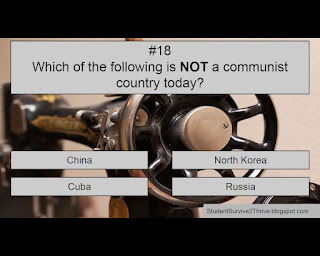 |
Which of the following is NOT a communist country today?
Answer choices include: China, North Korea, Cuba, Russia |
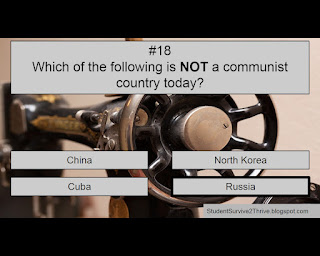 |
| The correct answer is Russia. |
 |
Which of the following is FALSE regarding labor unions?
Answer choices include:
They helped create laws making it illegal to hire children under age 9.
They engaged in collective bargaining for better working conditions & higher pay.
They provided more opportunities for women & children to work underground.
They allowed workers to strike if factory owners refused their demands. |
 |
The correct answer is:
They provided more opportunities for women & children to work underground. |
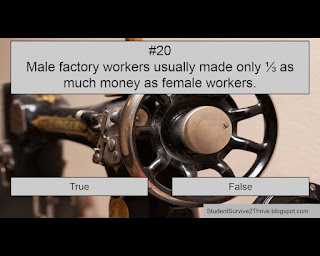 |
Male factory workers usually made only ⅓ as much money as female workers.
Answer choices include: true, false |
 |
| The correct answer is false. |
 |
| Find more resources at StudentSurvive2Thrive.blogspot.com |





























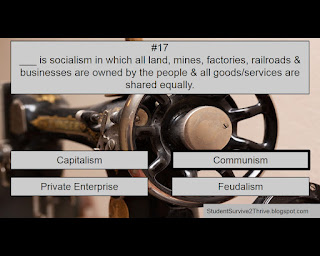














No comments:
Post a Comment
Thanks for reading my article and sending your comment! Please note that I do not place links to other web sites on this blog.
Note: Only a member of this blog may post a comment.